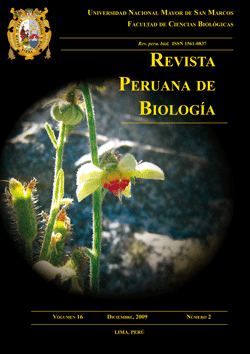Lankesterella poeppigii n. sp. (Apicomplexa, Lankesterellidae) from Bufo poeppigii (Tschudi, 1845) from Peru
DOI:
https://doi.org/10.15381/rpb.v16i2.200Keywords:
Lankesterella poeppigii n. sp., Bufo poeppigii, shizonts, oocysts, sporozoites.Abstract
Lankesterella poeppigii n. sp. is described from Bufo poeppigii (Tschudi, 1845) from Peru. Merogony and oogony occur in the capillary endothelium and the macrophages in the liver, spleen and kidneys. Meronts are oval, 25,2–29,4 x 15,7–16,8 μm in size and yield 35–46 merozoites. Oocysts are 26,3–29,4 x 15,1–17,6 μm in size; sporozoites 9,2-9,8 x 4,2–5,0 μm in size, assemble in macrophages. Released 8,7–9,8 x 2,8–3,1 μm sporozoites enter erythrocytes. L. poeppigii is compared with Lankesterella petiti Lainson & Paperna, 1995 infecting Bufo marinus (Linnaeus, 1758) in Brazil. The above mentioned specific characters, added to differences in hosts and geographical location warrant the description of Lankesterella poeppigii from B. poeppigii as a new species.Downloads
Downloads
Published
Issue
Section
License
Copyright (c) 2009 Ilan Paperna, Patrick Bastien, Jean-Marc Chavatte, Irène Landau

This work is licensed under a Creative Commons Attribution-NonCommercial-ShareAlike 4.0 International License.
AUTHORS RETAIN THEIR RIGHTS:
a. Authors retain their trade mark rights and patent, and also on any process or procedure described in the article.
b. Authors retain their right to share, copy, distribute, perform and publicly communicate their article (eg, to place their article in an institutional repository or publish it in a book), with an acknowledgment of its initial publication in the Revista Peruana de Biologia.
c. Authors retain theirs right to make a subsequent publication of their work, to use the article or any part thereof (eg a compilation of his papers, lecture notes, thesis, or a book), always indicating its initial publication in the Revista Peruana de Biologia (the originator of the work, journal, volume, number and date).






